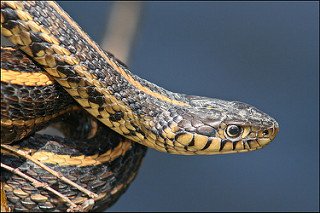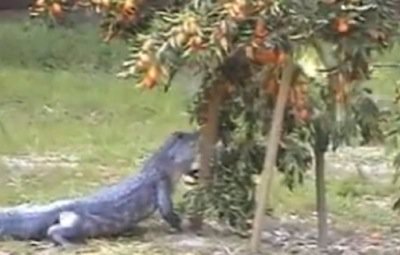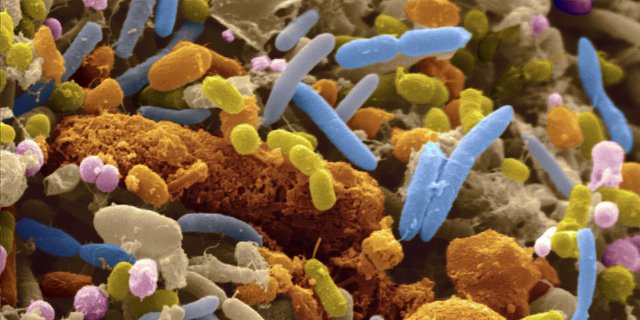So I've been having a bit of writer's block lately (hence my decreased activity) due to the colder weather and general lack of herptile activity. However, on my last post @beatminister left a comment that I thought would be a great subject for a post.
Reading this, it made me wonder: is there any snake species that is herbivorous - at least partially? I know it seems unlikely, but I have found that there is a exception to almost any rule in nature.
Did you ever hear anything like that about a snake?
When it comes to snakes, @beatminister is right: there is an exception to virtually every rule in the book...except when it comes to what type of food they eat. The fact that snakes are carnivores may be the one constant among all snake species; absolutely none feed even partially on plant matter.

Classifying all snakes as carnivores may not sound weird at first, until you really stop to think about this fact more in depth. Think about how common herbivory is among the different groups of vertebrates. Obviously a huge percentage of mammals feed exclusively on plant matter (with many more known to occasionally incorporate it into their diets; even animals that were once believed to be exclusively carnivorous are now known to eat plant matter). Many birds feed on the seeds and fruits of plants, and the bizarre Hoatzin in the Amazon basin even feeds exclusively on leaves. Fish like koi, goldfish and parrotfish are known herbivores, and others, such as catfish, are omnivores who aren't too choosy about what they eat. Most amphibian tadpoles are herbivores, and some adult amphibians, like the salamander sirens, will feed on algae all throughout their lives. Even other reptiles are herbivores; while most lizards will occasionally eat some vegetation, some like the marine iguana (which feeds on algae) are exclusive herbivores. Turtles and tortoises often largely eat only plant matter, and now even crocodilians are recognized for their habit of feeding on delicious fruits!

Yet there are no herbivorous snakes. Over 3,400 species of snakes exist around the world, making up more than 10% of all tetrapods on Earth... and none have evolved to eat plant matter.
To understand why this is, we have to understand how herbivores process the plants they eat...or rather how they do not. Herbivores that feed on leaves (or portions of plants with a high cellulose content) don't actually digest the food that they eat. Animals cannot produce cellulase enzymes to break down the bonds in cellulose and obtain the monosaccharide glucose, which they would metabolize for energy. Instead, they rely on symbiotic microbes that live inside their guts (in your gut too!).

In young herbivores, these microbes don't just appear on their own; they have to come from somewhere. These microbes are generally passed on from parents and other members of the species through life processes such as birth, nursing and coprophagy (eating poop) and later social interactions. Most herbivorous animals live in large herds or at least decently sized family groups which facilitates the spread of these microbes. Even among herbivorous reptiles, like the marine iguana, these animals rely on larger social groups to support their herbivorous lifestyle (even a partially herbivorous spider was recently discovered, and has been found to be more social than most other spiders). Snakes however are not quite social enough for the spread of the microbes; while 15-20% give live birth, some provide parental care and even socialize occasionally, there just isn't quite enough interaction to support the spread of crucial microbes.
The other problem is their physiology. Snakes have very specialized skulls and large teeth, well developed for swallowing large prey whole. Their teeth are wholly unsuited for chewing, which hervivorous animals must do to begin breaking down plant matter for digestion by microbes (think of a cow having to chew its food over and over and over). Digesting plants also requires a much longer, and more convoluted, gut to house all the microbes that are required for herbivory. Compare the guts of a carnivore and a herbivore and there is a huge difference in their internal structure; a snake's body simply doesn't have the room to house such a complex organ system.

There HAVE been instances of plants turning up inside snakes (or their feces) however. In most instances, these have been attributed to accidental ingestion, perhaps eaten with a prey item or mistaken for prey by scent. One interesting case was discovered by Harvey Lillywhite in a study published in the journal BioScience in 2008. Studying the scavenging behavior of pitvipers in the intertidal zone, Lillywhite observed cottomouth droppings that were composed almost entirely of seaweed. This was too much plant material to have been eaten secondarily or by accident, and he suspected that there was some other cause for the snakes to be eating it (it certainly wasn't for energy as the seaweed was passing through completely undigested. Lillywhite wondered if it was possible the snakes were feeding on seaweed simply because it smelled like fish. An interesting laboratory experiment proved their hypothesis correct; they offered various plants to cottonmouths, some with fish and others without. The plants without fish were investigated by the snakes, but ultimately left uneaten. Those that did contain fish were quickly devoured. Even when the fish was removed, the snakes ate the remaining seaweed simply because it smelled like their prey!

While the snakes may be ingesting the plant material, this is not herbivory. The snakes are still unable to process the vegetation, so they are not able to extract any nutrients or energy from it. Snakes may be rather unique in the fact that all known species are carnivores, but they remain among some of the most well adapted predators on the planet!
Source: http://snakesarelong.blogspot.com/

Really informative. I didn´t even know the difference between snakes´ intestines and other animals. I consider myself fairly knowledgeable in sciences... until I remember that biology is also a science, and I´m way behind there. I do enjoy a lot your articles however!
Downvoting a post can decrease pending rewards and make it less visible. Common reasons:
Submit
I still find it surprising nevertheless. Of course the currently existing snakes cannot opt to become vegetarians now. But during the many millions of years of their evolution, some should have developed the ability to make use of certain vegetarian products.
As I said before, not so much of real green plant material like grass or leafs or such stuff. As you correctly outline in this post, that would require a very specialized digestive system fundamentally different from the normal snake.
But a option to eat for example sweet fruit, or nuts or seeds with a high fat content, would not neccessarily need such big changes in design. Also some required micro organisms could be coming from eating herbivors like mice or such. As you say - there are plenty of other reptilians who managed to make this step towards a mixed, or even solely vegetarian diet. And the advantages are obvious: fruits and nuts usually dont try to run away or bite back if you want to eat them. :)
Downvoting a post can decrease pending rewards and make it less visible. Common reasons:
Submit
Woah this is a really good read never really thought of it before and it is quite odd that they have no herbivorous habits, I know even crocodiles show omnivorous habits at times like eating fruit. Definitely some food for thought!
Downvoting a post can decrease pending rewards and make it less visible. Common reasons:
Submit
Love your snake articles, they're very informative. Upvoted.
Downvoting a post can decrease pending rewards and make it less visible. Common reasons:
Submit
Yeah, my first thought was the jaws :) Interesting study about the seaweed eating snakes though. It's strange that they respond so thoroughly to only a single sensory cue indicating that this is food...
Downvoting a post can decrease pending rewards and make it less visible. Common reasons:
Submit
very interesting, very instructive. It looks like you like reptiles. 100% upvote for your passion :)
Downvoting a post can decrease pending rewards and make it less visible. Common reasons:
Submit
Really enjoyed that post 👏
Downvoting a post can decrease pending rewards and make it less visible. Common reasons:
Submit
Various venomous reptiles to very savage reptiles. I can learn, so I know which one is more venomous and which is more ferocious. This post is very useful for me.
Downvoting a post can decrease pending rewards and make it less visible. Common reasons:
Submit